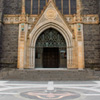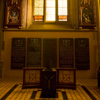|
 The original front door of St Patrick's Cathedral was a double-arched doorway with a pillar dividing it. This was removed before 1868. Its replacement was considered too narrow for ceremonial processions, and it too was replaced by the present doorway in 1939. The original front door of St Patrick's Cathedral was a double-arched doorway with a pillar dividing it. This was removed before 1868. Its replacement was considered too narrow for ceremonial processions, and it too was replaced by the present doorway in 1939.
|

by Fr Gerard Dowling,
Dean Emeritus of St Patrick's Cathedral
Melbourne’s St Patrick’s Cathedral, which stands majestically on Eastern Hill, has long established itself as a church edifice of superb grandeur and arguably one of the truly significant cathedrals of the world. From its consecration in 1897 to its ultimate completion in 1939 by the erection of its triple spires, it provides a continued act of adoration in stone and offers a superb setting of liturgical worship for the people of the archdiocese.
 In the north transept are the memorial tablets commemorating the lives of the Archbishops who are buried within the confines of the Cathedral: Archbishops Goold and Carr in the side chapels and Archbishops Mannix, Simmonds and Knox, who are buried in the crypt below the floor of the northern transept. In the north transept are the memorial tablets commemorating the lives of the Archbishops who are buried within the confines of the Cathedral: Archbishops Goold and Carr in the side chapels and Archbishops Mannix, Simmonds and Knox, who are buried in the crypt below the floor of the northern transept. |

William Wardell designed a number of brass items that can still be seen in the Cathedral's Sanctuary today. These are:
- A pair of Sanctuary lamps
- Paschal candle stand
- Eagle lectern
- Pair of gasoliers
 The altar mosaics were designed by William Wardell and made in Venice. The floor mosaics in all the chapels except the Ladye Chapel and the Blessed Sacrament Chapel, came from the workshop of Maw and Co Ltd., (Benthall works, Jackfield Salop, Shropshire). The altar mosaics were designed by William Wardell and made in Venice. The floor mosaics in all the chapels except the Ladye Chapel and the Blessed Sacrament Chapel, came from the workshop of Maw and Co Ltd., (Benthall works, Jackfield Salop, Shropshire). |
The largest sacristy is where the Archbishop and his assistant ministers vest for pontifical functions. All the original furnishings (presses, cupboards, tables, etc.) were designed by Wardell. Seven portraits of former Archbishops hang on the wall and a portrait of the current Archbishop, Most Reverend Denis J. Hart D.D. hangs on the wall there too.

Donors that have contributed to the Cathedral are acknowledged on bronze plaques placed on various pillars in the nave and ambulatory of the Cathedral.
 The main spire is surmounted by a cross, six metres in height. It was a gift from the Irish government in 1938.
The main spire is surmounted by a cross, six metres in height. It was a gift from the Irish government in 1938.
Gargoyles, a feature of Gothic cathedrals, were once thought of as protecting the building from evil spirits and serve as water spouts. The pinnacles of the Cathedral point skywards, as a reminder of Heaven.

Over a number of years Melbourne City Churches in Action (MCCIA) worked on a project to initiate an ecumenical walk through the City of Melbourne on Good Friday, to remember Jesus' walk to the Cross. The walk is marked by a series of 14 superb bronze sculptures which tell the story of the journey of Jesus from the Last Supper to the Cross. The 14 'stations' are placed outside various City Churches with two in the grounds of St Patrick's Cathedral.

By Mary Ryllis Clark
The Age, June 7 2002
Walk through the tall wrought-iron gates leading to St Patrick's Cathedral, turn right beside the statue of Archbishop Daniel Mannix, walk past St Catherine of Siena and you will come to the eastern transept or side-entrance. Look up and you will see two stone heads, one on each side of the stone arch. One is a lion; the other a man.
Many different types of building material sourced from around the world were used in the construction of the cathedral.